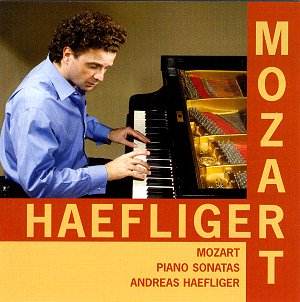These
four sonatas were composed within a year or so of each other in
1788-9, and are Mozart’s last works in the genre. The odd one
out is also the best-known; the C major Sonata K545 was deliberately
written ‘for beginners’, and now belongs in that unfortunate category
of piano ‘pop’ classics, along with the 1st movement
of the ‘Moonlight’, ‘Für Elise" and so forth. The other
three sonatas are very different fare: mature, complex works,
which show, in particular, Mozart’s increasing obsession with
contrapuntal intricacy. It’s a cunning compilation, for, while
there is an obvious case for grouping these pieces together, the
C major acts as ‘light relief’ from the comparative rigour of
the others.
I
enjoy Haefliger’s approach to this music enormously. The received
notion (i.e. that perpetrated by bad historians and musical snobs!)
is that Mozart’s piano sonatas are one of the least interesting
parts of his output, and therefore not of much interest to ‘serious’
pianists. It’s a daft point of view, of course, but one which
I have heard implicitly endorsed by many fine performers who ought
to know better. Endorsed, that is, in the way a Mozart sonata
is frequently positioned at the beginning of a recital as a sort
of finger-warmer, and then is played and in an infuriatingly twee
manner as if with kid-gloves! The tempi are usually too fast,
as well!
None
of that applies to Haefliger. He is clearly playing on a large
modern grand (no doubt a Steinway, though Avie don’t tell us –
I wish they would), and plays in a healthily unapologetic way,
quite prepared to use a certain weight of tone at appropriate
moments, though never overdoing it. K533, the first on the disc,
is possibly the most interesting of the four. It is certainly
the most quirky, with quite extraordinary tonal twists in the
development sections of the first two movements. Haefliger remains
clear-headed throughout these dizzying passages, and maintains
wonderfully lucid polyphonic textures. Tempi are well judged;
indeed, some listeners might find the apparent steadiness of the
finale of K533 quite a shock; but it is clearly marked Allegretto,
and the tempo allows Haefliger to avoid any sense of garbled rush
in the quicker sections. At this tempo, the little ornamental
flourishes that attach themselves to the main theme at each reappearance
can be relished, as can the gentle wit.
The
little C major sonata is played without a trace of condescension,
and emerges a better piece for it, while Haefliger’s simple expressiveness
in the lovely middle movement allows its innocence to be felt
poignantly. This uncomplicated approach persists throughout the
remaining sonatas, and is both refreshing and stimulating to listen
to. Anyone who thinks this music is easy to play just because
it doesn’t have thousands of notes in it has got the wrong end
of the musical stick. Mozart requires great discipline and a securely
grounded technique, precisely because its light, airy textures
allow everything to be heard – there is no hiding place!
The
recording is ideal – intimate, yet not so close as to emphasise
mechanical sound in the instrument. Haefliger is sometimes quite
noisy, with little intakes of breath, occasional grunts etc. But
that doesn’t bother me at all, and hopefully it won’t you either.
It’s nice to be reminded that there’s a real live musician inside
the box!
Gwyn
Parry-Jones
